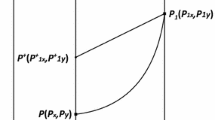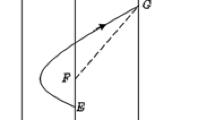Abstract
The numbers of pests and of natural enemies released to control them as part of integrated pest management strategies are density dependent. Therefore, the numbers of natural enemies to be released and the rate at which they kill pests should depend on their densities when the number of the pest population has reached the economic threshold. Bearing this in mind, a classic Lotka–Volterra system but with nonlinear state-dependent feedback control tactics is proposed and analysed in this paper. Furthermore, the definition and properties of the Poincaré map which is defined in the phase set were investigated for various cases, allowing us to address the existence and global stability of an order-1 periodic solution of the model with nonlinear feedback control. Moreover, the existence and nonexistence of periodic solutions with an order larger than 2 or 3 are also discussed. The modelling methods and analytical techniques developed could be widely used and applied in other systems with threshold control such as the glucose insulin regulatory system.



Similar content being viewed by others
References
Volterra, V.: Variations and fluctuations of the number of individuals in animal species living together. ICES J. Mar. Sci. 3(1), 3–51 (1928)
Sabelis, M.W., Diekmann, O., Jansen, V.A.A.: Metapopulation persistence despite local extinction: predator-prey patch models of the Lotka-Volterra type. Biol. J. Linn. Soc. 42, 267–283 (1991)
Boukal, D.S., Křivan, V.: Lyapunov functions for Lotka-Volterra predator-prey models with optimal foraging behavior. J. Math. Biol. 39, 493–517 (1999)
Seo, G., DeAngelis, D.L.: A predator-prey model with a Holling type I functional response including a predator mutual interference. J. Nonlinear. Sci. 21, 811–833 (2011)
Pang, P.Y.H., Wang, M.: Strategy and stationary pattern in a three-species predator-prey model. J. Differ. Equ. 200, 245–273 (2004)
Aziz-Alaoui, M.A., Daher, M.: Okiye: boundedness and global stability for a predator-prey model with modified Leslie-Gower and Holling-type II schemes. Appl. Math. Lett. 16, 1069–1075 (2003)
Zhang, S., Meng, X., Zhang, T.: Dynamics analysis and numerical simulations of a stochastic non-autonomous predator-prey system with impulsive effects. Nonlinear Anal. Hybrid Syst. 26, 19–37 (2017)
Roy, A.B., Solimano, F.: Global stability and oscillations in classical Lotka-Volterra loops. J. Math. Biol. 24, 603–617 (1987)
Choo, S.: Global stability in n-dimensional discrete Lotka-Volterra predator-prey models. Adv. Differ. Equ. NY. 11, 1–17 (2014)
Beretta, E., Capasso, V., Rinaldi, F.: Global stability results for a generalized Lotka-Volterra system with distributed delays: applications to predator-prey and to epidemic systems. J. Math. Biol. 26, 661–688 (1988)
Kuang, Y., Smith, H.L.: Global stability for infinite delay Lotka-Volterra type systems. J. Differ. Equ. 103, 221–246 (1993)
Li, Y., Kuang, Y.: Periodic solutions of periodic delay Lotka-Volterra equations and systems. J. Math. Anal. Appl. 255, 260–280 (2001)
Zhu, G., Meng, X., Chen, L.: The dynamics of a mutual interference age structured predator-prey model with time delay and impulsive perturbations on predators. Appl. Math. Comput. 216(1), 308–316 (2010)
Wang, B., Yan, J., Cheng, J., Zhong, S.: New criteria of stability analysis for generalized neural networks subject to time-varying delayed signals. Appl. Math. Comput. 314, 322–333 (2017)
Zeng, G., Chen, L., Chen, J.: Persistence and periodic orbits for two-species nonautonomous diffusion Lotka-Volterra models. Math. Comput. Model. 20, 69–80 (1994)
Cao, F., Chen, L.: Asymptotic behavior of nonautonomous diffusive Lotka-Volterra model. System Sci. Math. Sci. 11, 107–111 (1998)
Cui, J., Chen, L.: Permanence and extinction in logistic and Lotka-Volterra systems with diffusion. J. Math. Anal. Appl. 258, 512–535 (2001)
Hastings, A.: Global stability in Lotka-Volterra systems with diffusion. J. Math. Biol. 6, 163–168 (1978)
Flint, M.L., van den Bosch, R.: Introduction to integrated pest management. Plenum press, New York (1981)
Van Lenteren, J.C.: Integrated pest management in protected crops. In: Dent D (ed) Integrated Pest Management, pp. 311–320. Chapman Hall, London (1995)
Tang, S.Y., Chen, L.S.: Modelling and analysis of integrated pest management strategy. Discrete Cont. Dyn. B 4, 759–768 (2004)
Tang, S.Y., Cheke, R.A.: State-dependent impulsive models of integrated pest management (IPM) strategies and their dynamic consequences. J. Math. Biol. 50, 257–292 (2005)
Tang, S.Y., Xiao, Y.N., Chen, L.S., Cheke, R.A.: Integrated pest management models and their dynamical behaviour. B. Math. Biol. 67, 115–135 (2005)
Liu, B., Zhang, Y.J., Chen, L.S., Sun, L.H.: The dynamics of a prey-dependent consumption model concerning integrated pest management. Acta Math. Sin. 21(3), 541–554 (2005)
Liu, X.N., Chen, L.S.: Complex dynamics of Holling type II Lotka-Volterra predator-prey system with impulsive perturbations on the predator. Chaos Solitons Fract. 16, 311–320 (2003)
Tang, S.Y., Tang, B., Wang, A.L., Xiao, Y.N.: Holling II predator-prey impulsive semi-dynamic model with complex Poincare map. Nonlinear Dynam. 81, 1579–1596 (2015)
Yang, J., Tang, S.: Holling type II predator-prey model with nonlinear pulse as state-dependent feedback control. J. Comput. Appl. Math. 291, 225–241 (2016)
Feng, L., Liu, Z.: An impulsive periodic predator-prey Lotka-Volterra type dispersal system with mixed functional responses. J. Appl. Math. Comput. 45, 235–257 (2014)
Tang, S.Y., Pang, W.H., Cheke, R.A., Wu, J.H.: Global dynamics of a state-dependent feedback control system. Adv. Differ. Equ. 2015(1), 322 (2015)
Wang, X., Tian, Y., Tang, S.: A holling type II pest and natural enemy model with density dependent IPM strategy. Math. Probl. Eng. 2017, 1–12 (2017)
Corless, R.M., Gonnet, G.H., Hare, D.E.G., Jeffrey, D.J., Knuth, D.E.: On The Lambert W function. Adv. Comput. Math. 5, 329–359 (1996)
Ciesielski, K.: On stability in impulsive dynamical systems. Bull. Pol. Acad. Sci. Math. 52, 81–91 (2004)
Kaul, S.: On impulsive semidynamical systems. J. Math. Anal. Appl. 150, 120–128 (1990)
Kaul, S.: On impulsive semidynamical systems III: Lyapunov stability. Recent Trends Differ. Equ. Ser. Appl. Anal. 1, 335–345 (1992)
Bainov, D.D., Simeonov, P.S.: Systems with Impulse Effect: Stability. Theory and Applications. Ellis Hordwood limited, Chichester (1989)
Ciesielski, K.: On semicontinuity in impulsive dynamical systems. Bull. Pol. Acad. Sci. Math. 52, 71–80 (2004)
Gao, W., Tang, S.Y.: The effects of impulsive releasing methods of natural enemies on pest control and dynamical complexity. Nonlinear Anal. Hybri. 5, 540–553 (2011)
Jiang, G., Lu, Q., Qian, L.: Complex dynamics of a Holling type II prey-predator system with state feedback control. Chaos Solitons Fract. 31, 448–461 (2007)
Li, S., Liu, W.: A delayed Holling type III functional response predator-prey system with impulsive perturbation on the prey. Adv. Differ. Equ. 2016, 42 (2016)
Huang, M.Z., Li, J.X., Song, X.Y., Guo, H.J.: Modeling impulsive injections of insulin: towards artificial pancreas. SIAM J. Appl. Math. 72, 1524–1548 (2012)
Acknowledgements
This work was supported by the National Natural Science Foundation of China (NSFCs, 11471201, 11631012, 61772017), and by the Fundamental Research Funds for the Central Universities GK201701001, and by the Youth Foundation of Hubei University For Nationalities MY2017Q007.
Author information
Authors and Affiliations
Corresponding author
Ethics declarations
Conflicts of interest
All the authors declare that they have no conflict of interest.
Rights and permissions
About this article
Cite this article
Tian, Y., Tang, S. & Cheke, R.A. Nonlinear state-dependent feedback control of a pest-natural enemy system. Nonlinear Dyn 94, 2243–2263 (2018). https://doi.org/10.1007/s11071-018-4487-4
Received:
Accepted:
Published:
Issue Date:
DOI: https://doi.org/10.1007/s11071-018-4487-4




